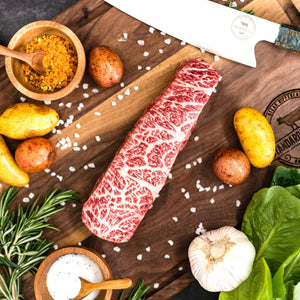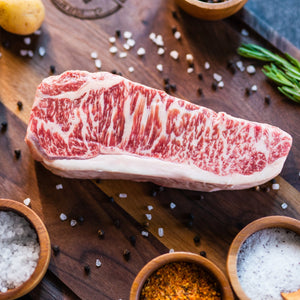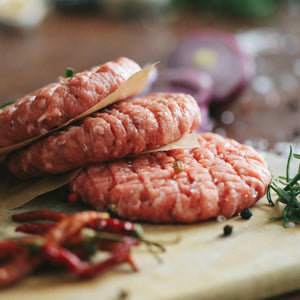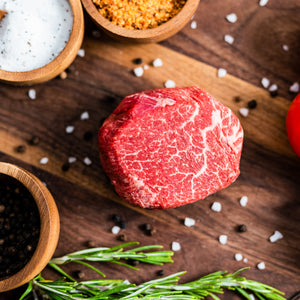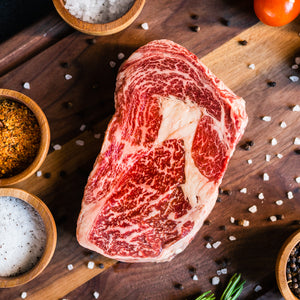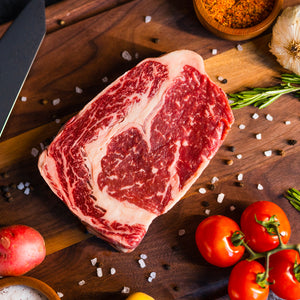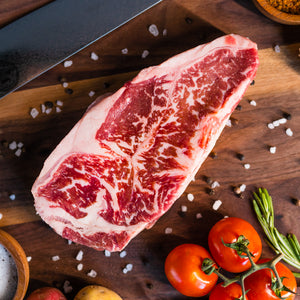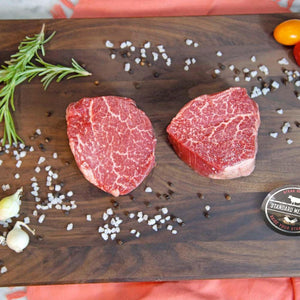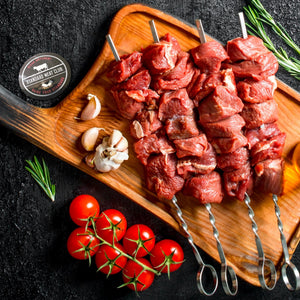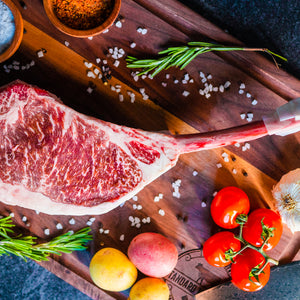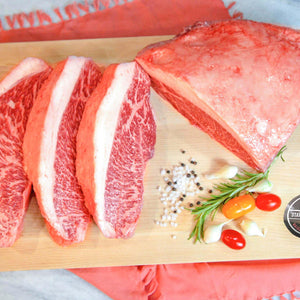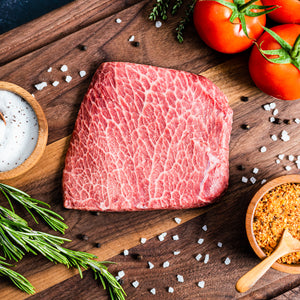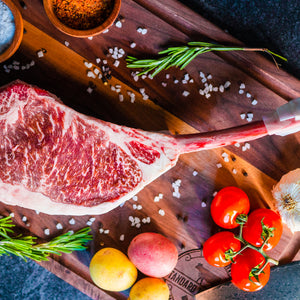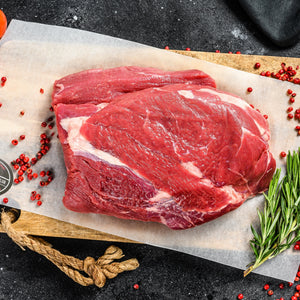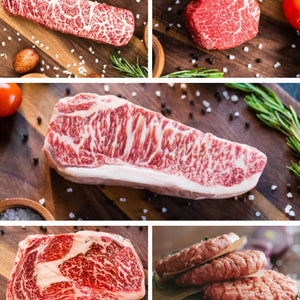Mastering the Art of Butchering Tenderloin, Ribeye, & NY Strip 🍖🔪
Feb 21, 2025
🔪 Essential Tools & Safety First
Before diving into butchering, gather these essential tools and follow these safety guidelines:
- Sharp Knife: A high-quality chef’s or boning knife is crucial for making smooth, precise cuts. A dull knife can slip and damage the meat.
- Sturdy Cutting Board: Use a heavy, non-slip board—ideally a custom wooden board—to keep the meat steady while you work.
- Safety Gear: Wear kitchen gloves if you’re new to butchering. Keep a clean towel nearby for a firm grip and to wipe off any stray bits.
Expert Tip: Regularly sharpen your knife. It’s like maintaining a favorite tool; a sharp knife makes all the difference in ease and safety. 🗡️✨
🥩 Tenderloin: The Butter-Soft Beauty
Tenderloin is known for its extraordinary tenderness and smooth texture. Here’s how to handle it:
Step-by-Step Process
-
Locate the Silverskin:
- The tenderloin is covered by a thin, silvery membrane called the silverskin. It doesn’t break down during cooking and can make the meat chewy if left on.
- How to Remove: Slide your knife gently under the silverskin, holding the meat with one hand, and carefully cut it away. Think of it as peeling a sticker off a smooth surface—gentle and steady is key. 🍃
-
Decide on Portions:
- For Steaks (Filet Mignon): Cut the tenderloin into thick, even medallions.
- For a Roast: Leave it as one large piece to cook evenly.
- Why It Matters: Even portions ensure that each piece cooks uniformly, giving you a perfect texture every time.
-
Cutting Technique:
- Use long, smooth strokes rather than a sawing motion. This preserves the meat’s delicate fibers and gives you cleaner cuts.
- Visual Tip: Imagine slicing through soft butter—gentle, confident cuts are all you need.
-
Final Prep:
- Once cut, pat the meat dry with a paper towel. Removing excess moisture helps create a better sear during cooking.
Expert Tip: When trimming, take your time to get as close to the meat as possible without losing too much of the tenderloin. This maximizes your yield and preserves the quality of every bite. 👍
🥩 Ribeye: The Flavor-Packed Classic
Ribeye is cherished for its robust flavor and abundant marbling. Here’s a deeper look at the process:
Step-by-Step Process
-
Bone Consideration:
- If your ribeye comes with bones, decide if you want boneless steaks or if you’d like to keep the bones for extra flavor during cooking.
- Why Bones Matter: Bones can enhance the taste and keep the meat juicy, but boneless cuts are easier to slice and serve.
-
Cutting Against the Grain:
- What Is the Grain?: The grain refers to the direction in which the muscle fibers run.
- How to Identify: Look closely at the meat to spot the lines of muscle fibers.
- The Cut: Slice perpendicular (at a right angle) to these fibers. This shortens the muscle strands, resulting in a more tender bite.
- Imagine: Cutting a long piece of string into shorter sections—it makes the texture less chewy and easier to bite.
-
Portioning the Meat:
- Aim for steaks that are around 1 to 1.5 inches thick. This thickness is ideal for both grilling and pan-searing.
- Uniformity: Consistent thickness ensures even cooking across each steak.
-
Marbling:
- Avoid trimming off too much of the fat. The marbling (intramuscular fat) is essential for the ribeye’s flavor and juiciness.
- Tip: A bit of extra fat melts during cooking, adding a burst of flavor and moisture.
Expert Tip: After cutting, let your ribeye steaks rest for a few minutes. This resting time allows the juices to redistribute within the meat, ensuring a flavorful and succulent steak every time. 🔥
🥩 NY Strip (Striploin): The Balanced Beauty
NY Strip offers a perfect combination of tenderness and beefy flavor. Here’s a detailed breakdown:
Step-by-Step Process
-
Trimming the Fat:
- NY Strip often has a layer of fat on one side. While this fat contributes to flavor, you might want to trim any excessively thick or uneven parts.
- Keep Some Fat: Leaving a moderate amount helps keep the meat moist and adds flavor during cooking.
-
Cutting Against the Grain:
- Just like with ribeye, identify the direction of the muscle fibers and slice perpendicular to them.
- Why?: This technique makes each bite tender by shortening the muscle strands.
-
Uniform Thickness:
- Aim for steaks about 1 to 1.5 inches thick. Uniform slices ensure that your steaks cook evenly, whether you’re grilling or pan-searing.
- Visual Cue: Picture cutting a loaf of bread into equal slices—consistency is key for an even cook.
-
Presentation:
- A slight diagonal cut can make the steak look more appealing while also ensuring a better sear.
- Style Note: Attractive presentation is not only pleasing to the eye but also a sign of a well-prepared dish.
Expert Tip: Allow your NY Strip steaks to come to room temperature before cooking. This simple step helps the meat cook more evenly, making for a better dining experience. 🍽️👌
🌟 Final Expert Tips for Butchering Like a Pro
-
Practice Patience:
Rushing the process can lead to uneven cuts and increased risk of accidents. Take your time, and your skills will improve with practice. -
Invest in Quality Tools:
A well-maintained, sharp knife and a reliable cutting board are the cornerstones of great butchering. They not only make your job easier but also help maintain the quality of your meat. -
Keep Your Workspace Clean:
A tidy, well-organized workspace minimizes accidents and makes the process smoother. Clean as you go to ensure safety. -
Mind the Grain:
Always observe the direction of the muscle fibers before cutting. This simple observation can make a huge difference in the tenderness of your meat. -
Rest is Best:
After cutting, let the meat rest briefly before cooking. This resting time allows the juices to settle, giving you a more flavorful and moist steak.
By following these detailed steps and expert tips, you can confidently butcher and cut your tenderloin, ribeye, and NY strip into perfect portions. Whether you’re a beginner or looking to refine your skills, these techniques will help you create mouthwatering, restaurant-quality steaks at home. Enjoy the process and happy cooking! 🍖🔥😊

